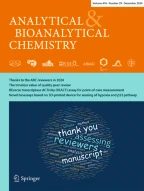Abstract.
This study describes the application of a novel, reactive matrix for the mass spectral analysis of steroids by capillary-high performance liquid chromatography (capillary-HPLC) coupled to matrix-assisted laser desorption/ionization (MALDI). The mass spectral analysis of steroids was accomplished after fully automated peak deposition of chromatographic peaks onto MALDI targets. The seven corticosteroids used as test compounds were: triamcinolone, prednisone, cortisone, fludrocortisone, dexamethasone, deoxycorticosterone, and budesonide. They were separated using a PepMap C18 (3 μm particle size, 100 Å pore width) column at five different concentration levels of 25, 15, 7.5, 2.5 and 1 ng/μL, and the peaks were detected at a wavelength of 237 nm. The column effluent was mixed with 2,4-dinitrophenylhydrazine (DNPH) directly following the UV detector. The chromatographic peaks were then deposited onto the MALDI target with a robotic micro-fraction collector triggered by the UV detector signals. A special hydrophobic surface coating allowed the deposition of up to 4 μL (up to 90 % of the chromatographic peak volume) onto one sample spot. The compounds were then identified by MALDI mass spectrometry. Depending on the nature of the analyte, radical cations ([M]+.) and sodium adduct ions ([M+Na]+) of the steroids as well as protonated steroid-dinitrophenylhydrazone derivatives ([MD+H]+) were detected in positive ion mode. The detection limits were between 0.5 and 15 ng injected with capillary-HPLC-MALDI-TOF-MS and between 0.3 and 3 ng on target with MALDI-TOF when deposited manually.
This is a preview of subscription content,log in via an institution to check access.
Access this article
Subscribe and save
- Get 10 units per month
- Download Article/Chapter or eBook
- 1 Unit = 1 Article or 1 Chapter
- Cancel anytime
Buy Now
Price includes VAT (Japan)
Instant access to the full article PDF.




Similar content being viewed by others
Explore related subjects
Discover the latest articles and news from researchers in related subjects, suggested using machine learning.References
Karas M., Hillenkamp F. (1988) Anal Chem 60:2299–2301
Tanaka K., Waki H., Ido Y., Akita S., Yoshida Y., Yoshida T. (1988) Rapid Commun Mass Spectrom 2:151–153
Zenobi R., Knochenmuss R. (1998) Mass Spec Rev 17:337–366
Busch K. L. (1999) Spectroscopy 14:14–16
Cohen S. L., Chait B. T. (1996) Anal Chem 68:31–37
Önnerfjord P., Ekstrom S., Bergquist J., Nilsson J., Laurell T., Marko-Varga G. (1999) Rapid Commun Mass Spec 13:315–322
Doroshenko V. M., Laiko V. V., Taranenko N. I., Berkout V. D., Lee H. S. (2002) Int J Mass Spec 221:39–58
Moyer S. C., Cotter R. J. (2002) Anal Chem 17:469A–476A
LeRiche, T., Osterodt J., Volmer D. A. (2001) Rapid Commun Mass Spectrom 15:608–614
Andalo C., Bocchini P., Pozzi R., Galletti G. C. (2001) Rapid Commun Mass Spectrom 15:
Biot C., Caron S., Maciejewski L. A., Brocard J. S. (1998) J Labelled Compd Radiopharm 41:911–918
Cohen L. H., Gusev A. I. (2002) Anal Bioanal Chem 373:571–586
Nicola A. J., Gusev A. I., Proctor A., Jackson E. K., Hercules D. M. (1995) Rapid Commun Mass Spectrom 9:1164–1171
Zhu Y. F., Lee K. L., Tang K., Allman S. L., Taranenko N. I., Chen C. H. (1995) Rapid Commun Mass Spectrom 9:1315–1320
Harvey D. J. (1999) Mass Spectrom Rev 18:349–451
Harvey D. J. (1993) Rapid Commun Mass Spectrom 7:614–619
Keil O., LeRiche T., Deppe H., Volmer D. A. (2002) Rapid Commun Mass Spectrom 16:814–820
Vogel M., Büldt A., Karst U. (2000) Fresenius J Anal Chem 366:781–791
Camel V., Caude M. (1995) J Chromatogr A 710:3–19
Grosjean D., Grosjean E. (1995) Int J Environ Anal Chem 61:343–360
Tholey A., Wittmann C., Kang M.-J., Bungert D., Hollemeyer K., Heinzle E. (2002) J Mass Spectrom 37:963–973
Zhang L.-K., Gross M. L. (2002) J Am Soc Mass Spectrom 13:1418–1426
Volmer D. A., Hui J. P. M. (1997) Rapid Commun Mass Spectrom 11:1926–1934
Carey F. A. Sundberg R. J. (1990) Advanced Organic Chemistry. Plenum Press, New York 3:802
Allwood D. A., Dreyfus R. W., Perera I. K., Dyer P. E. (1996) Rapid Commun Mass Spectrom 10:1575–1578
Allwood D. A., Dreyfus R. W., Perera I. K., Dyer P. E. (1997) Appl Surf Sci 109/110:154–157
Owen S. J., Brombacher S., Volmer D. A. (2003) In preparation
Kölliker S., Oehme M. (1998) Anal Chem 70:1979–1985
Brombacher S., Oehme M., Beukes J. A. (2001) J Environ Monit 3:311–316
Gobom J., Mueller M., Egelhofer V., Theiss D., Lehrach H., Nordhoff E. (2002) Anal Chem 74:3915–3923
Author information
Authors and Affiliations
Institute for Marine Biosciences, National Research Council, 1411 Oxford Street, Halifax, Nova Scotia, B3H 3Z1, Canada
Stephan Brombacher, Stacey J. Owen & Dietrich A. Volmer
- Stephan Brombacher
You can also search for this author inPubMed Google Scholar
- Stacey J. Owen
You can also search for this author inPubMed Google Scholar
- Dietrich A. Volmer
You can also search for this author inPubMed Google Scholar
Corresponding author
Correspondence toDietrich A. Volmer.
Rights and permissions
About this article
Cite this article
Brombacher, S., Owen, S.J. & Volmer, D.A. Automated coupling of capillary-HPLC to matrix-assisted laser desorption/ionization mass spectrometry for the analysis of small molecules utilizing a reactive matrix.Anal Bioanal Chem376, 773–779 (2003). https://doi.org/10.1007/s00216-003-2024-9
Received:
Revised:
Accepted:
Published:
Issue Date:
Share this article
Anyone you share the following link with will be able to read this content:
Sorry, a shareable link is not currently available for this article.
Provided by the Springer Nature SharedIt content-sharing initiative


